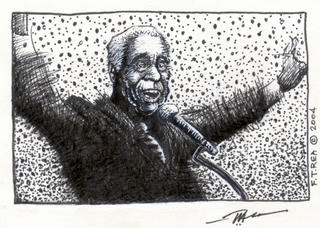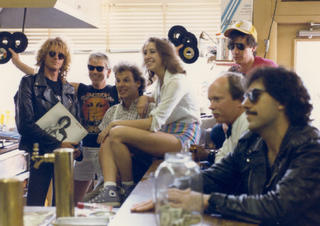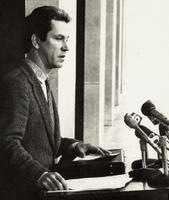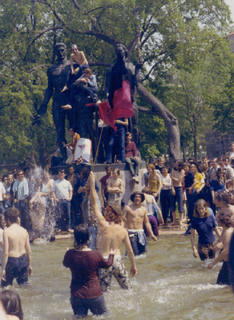 "...And now I'm back to let you know
"...And now I'm back to let you know
I can really shake 'em down" -- from "Do You Love Me" by Berry Gordy, Jr. (1962)
by F. T. Rea
Have you been Downtown lately? Seen as wallowing in despair only a few years ago, Richmond’s downtown has several major construction projects in various stages of being realized. Mammoth department store Thalhimers, a hub of the retail whirl that dominated that landscape for most of the 20th century, is gone. Most of the failed 6th Street Marketplace -- a bitter symbol of Downtown Richmond’s more recent period of decline, folly and official malfeasance -- has been swept away, too.
A new federal courthouse is being built at 7th and Broad Streets. To the west, the refurbishing of one old theater is underway and three more live-stage venues are slated to be constructed. There’s a plan to convert what was the Miller and Rhoads department store into a hotel. The John Marshall Hotel building is on its way to becoming a luxury apartment complex. Corporate giant Philip Morris is poised to create a $300 million research center a few blocks north of Broad. Looking eastward, with trains chugging through Main Street Station, once again, some see the shoehorning of a new baseball stadium into Shockoe Bottom as doable.
This piece will deal only with Mayor L. Douglas Wilder’s high profile refusal to hop onboard what was once thought to be an unstoppable theater-building bandwagon of the Virginia Performing Arts Foundation.
The VPAF is already in the process of renovating the Carpenter Center (formerly the Loew’s), to the tune of $28 million. The total price tag on the VPAF vision for a spectacular new performing arts center to open in 2007 on the Thalhimers block is $93 million. It calls for building three new stages -- a performance hall, a community playhouse and a jazz club -- on the old Thalhimers site. That figure above doesn’t include what the same outfit wants to spend on renovating three other old theaters -- the National, the Landmark (formerly the Mosque) and the Empire.
As the VPAF plans (see www.vapaf.com) rest heavily on convincing the Commonwealth of Virginia and the City of Richmond to throw large sums into the kitty, elected officials should take an interest in how that nonprofit organization raises and handles money. As well, how wise the VPAF was in developing its original strategy is still a proper matter for them to scrutinize.
Accordingly, Mayor Wilder has asked the VPAF some questions that its president, former adman Brad Armstrong, has done an awkward job of answering. That Armstrong gave the appearance of resenting being asked at all seems odd, even worrisome.
Speaking of being worried, I still wonder how much the VPAF knows about the business side of the performing arts game. The one VPAF official with actual hands-on show biz experience, Joel Katz (formerly the Carpenter Center’s general manager), was fired recently. After the sudden dismissal of Katz is better understood, and it ought to be, someone -- perhaps Hizzoner? -- ought to ask the VPAF just what it actually knows about establishing or operating theaters. Who's left with any industry experience?
Note: I ran a movie theater (the Biograph) for nearly 12 years. Back then, every week, I listened dozens of helpful movie-goers tell me just how to run the place better and, of course, which movies to play. So, I'm familiar with the idea that lots of people imagine they know how to operate a theater without any experience in the entertainment business.
Here are a few more questions: What kind of town has Richmond been, with regard to the business side of entertainment? How well do plays and other touring attractions gross here, as compared to other cities? What do national promoters and movie distributors think of the Richmond market? Since cutting edge, ambitious nightlife venues here have tended to crash and burn in recent decades, what has the VPAF done to understand the whys? How well does it understand why smart private money has avoided building new theaters or night clubs in that same neighborhood for decades? This matters!
There’s a volunteer watchdog organization in town, Save Richmond (see www.saverichmond.com), which asserts that the VPAF all but ignored input from most of the local pros -- the folks who have worked in Richmond’s entertainment industry as the talent, the producers, the bookers, and so forth. If that’s true, it’s not a good sign.
Armstrong’s position that Richmond ought to stay with the original program, even though his organization’s fundraising performance failed to meet its published goals, may have been good enough for those on City Council. But it obviously struck Mayor Wilder as presumptuous.
At this point -- all blue sky stories aside -- doesn’t the VPAF have a fallback plan? Is this really an all-or-nothing situation? Can’t we finish up one theater, fill it up a few times, pay some bills. Then, perhaps, we build a second theater, etc.
The VPAF has done such a poor job of selling this deal to John Q. Public -- who may not easily imagine himself attending an opera or symphony show -- that it’s difficult to weigh what real merit aspects of the plan might have. The concept of establishing a modern theater/night club district in that area, where it thrived 100 years ago, doesn't seem wrongheaded.
However, if you made that same area an enterprise zone where Richmond's stifling seven percent admissions tax wasn't scraped off the top of ticket sold, private money might be easier to find. That tax has played a hidden but significant role in hobbling theaters and clubs for a long time.
A glance at the VPAF’s board, which includes familiar names such as Bliley, Cantor, Markel, Massey, Reynolds, Robins, Rosenthal, Scott, Thalhimer and Ukrop offers some insight as to why Armstrong might think he can trump Wilder's moves. But since the well-heeled arts-lovers who support the VPAF’s four state-of-the-art stages on one block concept don’t seem to want to risk much of their own money, the VPAF still needs a lot of public money -- the voters’ money.
So far, City Council has decided to stay on the build-it-and-they-will-come bandwagon. This bunch doesn’t seem to grasp that with 80 percent of the voters behind him, as long as Wilder successfully positions himself as moving to prevent another 6th Street Marketplace-like boondoggle then his foes' chances in the court of public opinion aren't all that good.
This imbroglio shouldn't be about supporting art, or not, so much as it should be about what constitutes proper planning. If the focus of concern moves from money to bona fide know-how, watch out standing too close to the sputtering VPAF bandwagon. As more fat cats and wannabes jump off of it, one of them might land on you.
-- 30 --
 Wronging Wainwright
Wronging Wainwright 







